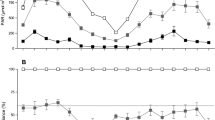Abstract
Diminished sunlight, characteristic of urban canyons, has been suggested as being potentially limiting to plant growth. This study investigated the response of sweetgum (Liquidambar styraciflua L.) to variable irradiance in a range of urban locations. Diurnal photosynthesis was measured in situ on mature trees, comparing an open site at an urban park with an urban canyon that received 4 h of midday sun in midsummer. Photosynthesis for trees growing in the canyon was lower both during shaded and sunlit periods compared with trees at the park. Photosynthesis of detached shoots in a growth chamber was greater in canyon than park foliage at low irradiance, indicating possible photosynthetic shade acclimation analogous to tree species growing in the forest understorey. Shoot and trunk growth and morphological characteristics were measured onL. styraciflua growing along boulevards at 15 additional urban sites and related to seasonal interception of solar radiation. Angular elevation and orientation of buildings and trees that defined the horizon topography at each site were used in modeling the potential irradiance of global shortwave radiation. Seasonal irradiance among sites ranged from 21% in the urban core to nearly 95% in outlying residential districts of that potentially received under an unobstructed horizon. Shade acclimation was confirmed by differences in leaf morphology, as foliage became flatter, thinner, and more horizontally oriented at sites with lower irradiance. Photosynthetic and morphological acclimation to shade did not compensate for lower available radiant energy as both shoot and trunk growth decreased at sites of lower irradiance. Unlike the forest understorey, the static light environment of urban canyons may subject shade-intolerant species such asL. styraciflua to chronic, low-radiant-energy stress.
Similar content being viewed by others
References
Atkinson C (1984) Quantum flux density as a factor controlling the rate of growth, carbohydrate partitioning and wood structure ofBetula pubescens seedlings. Ann Bot 54:397–411
Bazazz F, Carlson R (1982) Photosynthetic acclimation ot variability in the light environment of early and late successional plants. Oecologia 54:313–316
Bjorkman O (1981) Responses to different flux densities. In: Lange O, Nobel P, Osmond C, Zeigler H (eds) Physiological plant ecology I: Responses to the physical environment. Encyclopedia of plant physiology, new series, vol 12A. Springer-Verlag, New York, pp 57–107
Canham C (1989) Different responses to gaps among shade-tolerant tree species. Ecology 70:540–548
Chabot B, Jurik W, Chabot J (1979) Influence of instantaneous and integrated light-flux density on leaf anatomy and photosynthesis. Am J Bot 66:940–945
Clark J, Kjelgren R (1989) Conceptual and management considerations for the development of urban tree plantings. J Arboric 15:229–236
Duba S, Carpenter S (1980) Effect of shade on the growth, leaf morphology, and photosynthetic capacity of an American sycamore clone. Castanea 45:219–227
Federer C (1971) Effects of trees in modifying urban microclimates. In: Proceedings of Symposium Role of Trees in the South's Urban Environment. USDA Forest Service, p 26
Flint A, Childs S (1987) Calculation of solar radiation in mountainous terrain. Agric Meteorol 40:233–249
Fowells H (1965) Sweet Gum. In: Silvics of forest trees of the US. Agriculture Handbook no 271, USFS/USDA, pp 248–254
Gilbertson P, Bradshaw A (1985) Tree survival in cities: The extent and nature of the problem. Arboric J 9:131–142
Givnish T (1988) Adaption to sun and shade: a whole-plant approach. Aust J Plant Physiol 15:63–92
Goulet F, Bellefleur P (1986) Leaf morphology plasticity in response to light environment in deciduous tree species and its implication on forest succession. Can J For Res 16:1192–1195
Iqbal M (1983) An introduction to solar radiation. Academic Press, New York
Jurik T (1986) Temporal and spatial patterns of specific leaf weight in successional northern hardwood tree species. Am J Bot 73:1083–1092
Kjelgren R (1988) Growth and development ofLiquidambar styraciflua L. in three urban microclimates in Seattle, Washington. PhD Thesis, University of Washington, USA
Landsberg H (1981) Urban energy fluxes. Int Geophys Ser 28:53–82
Leverenz J (1978) The effects of light flux and direction on net photosynthesis in sitka spruce. PhD Thesis, University of Aberdeen, Scotland
Lichtenthaler H (1985) Differences in morphology and chemical composition of leaves grown at different light intensities and qualities. In: Baker N, Davies W, Ong C (eds) Control of leaf growth. Soc Exp Biol Ser no. 27, Cambridge University Press, Cambridge, UK, pp 201–221
Loach K (1970) Shade tolerance in tree seedlings I: growth analysis of plants raised under artificial shade. New Phytol 69:273–286
McLendon J, McMillen G (1982) The control of leaf morphology and the tolerance of shade by woody plants. Bot Gaz 143:79–83
McMillen G, McLendon J (1979) Leaf angle: An adaptive feature of sun and shade leaves. Bot Gaz 140:437–442
O'Rourke P, Terjung W (1981) Relative influence of city structure on canopy photosynthesis. Int J Biometeorol 25:1–19
Patterson J, Murray J, Short J (1980) The impact of urban soil on vegetation. In: METRIA-3, Proceedings Third Conference. Metropolitan Tree Alliance, Rutgers University, pp 33–56
Sievers U, Zdunkowski W (1985) A numerical simulation scheme for the albedo of city street canyons. Bound Layer Meteorol 33:245–257
Teskey R, Shrestha R (1985) A relationship between carbon dioxide, photosynthetic efficiency and shade tolerance. Physiol Plant 63:126–132
Turner N, Schulze E, Gollan T (1984) The responses of stomata and leaf gas exchange to vapour pressure deficits and soil water content. Oecologia 63:338–342
Whitlow T, Bassuk N (1988) Ecophysiology of urban trees and their management — the North American experience. Hortscience 23:547–552
Zar J (1984) Biostatistical analysis, 2nd edn. Prentice-Hall, Englewood Cliffs, New Jersey
Author information
Authors and Affiliations
Rights and permissions
About this article
Cite this article
Kjelgren, R.K., Clark, J.R. Photosynthesis and leaf morphology ofLiquidambar styraciflua L. under variable urban radiant-energy conditions. Int J Biometeorol 36, 165–171 (1992). https://doi.org/10.1007/BF01224821
Received:
Revised:
Accepted:
Issue Date:
DOI: https://doi.org/10.1007/BF01224821




